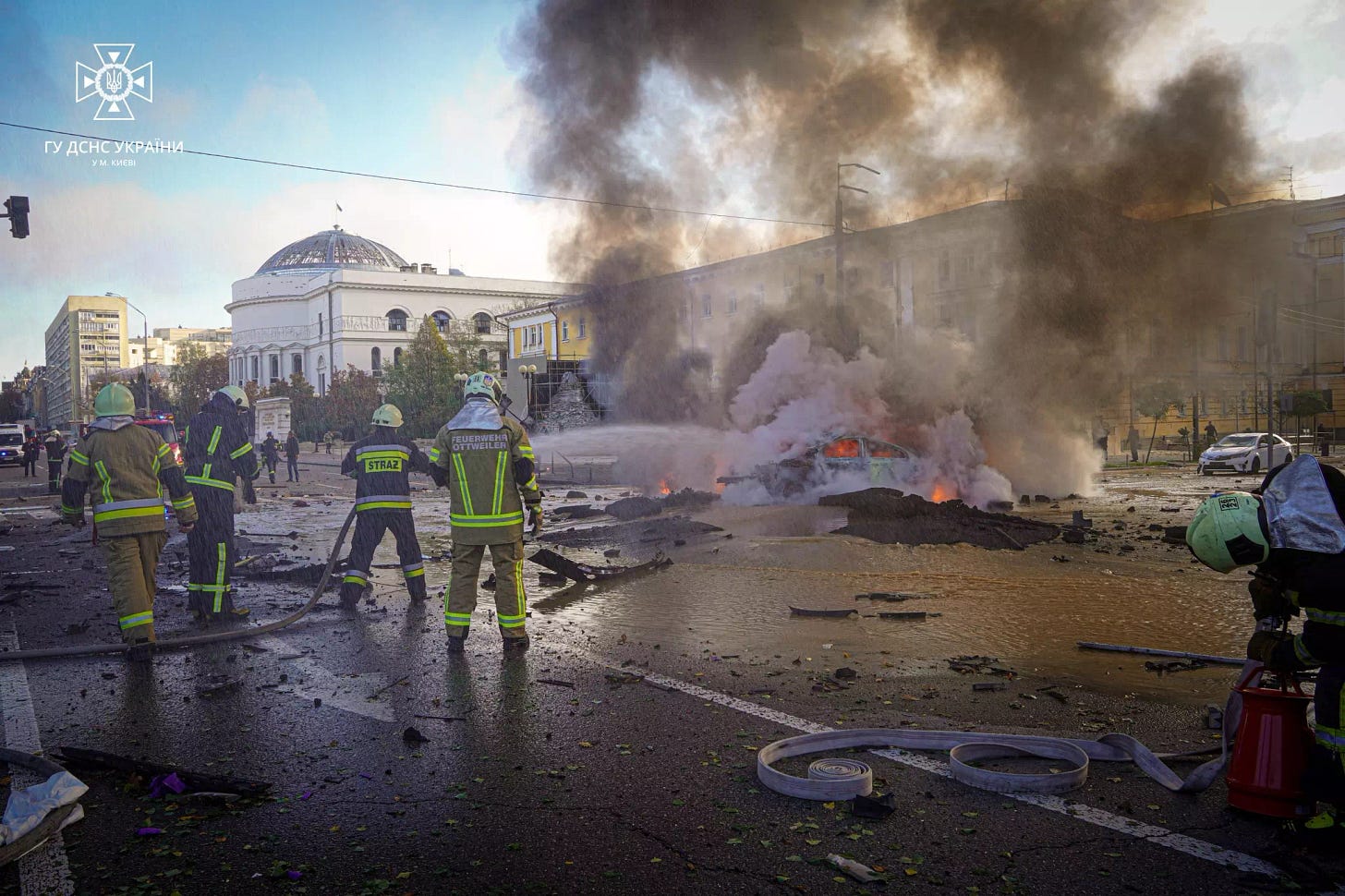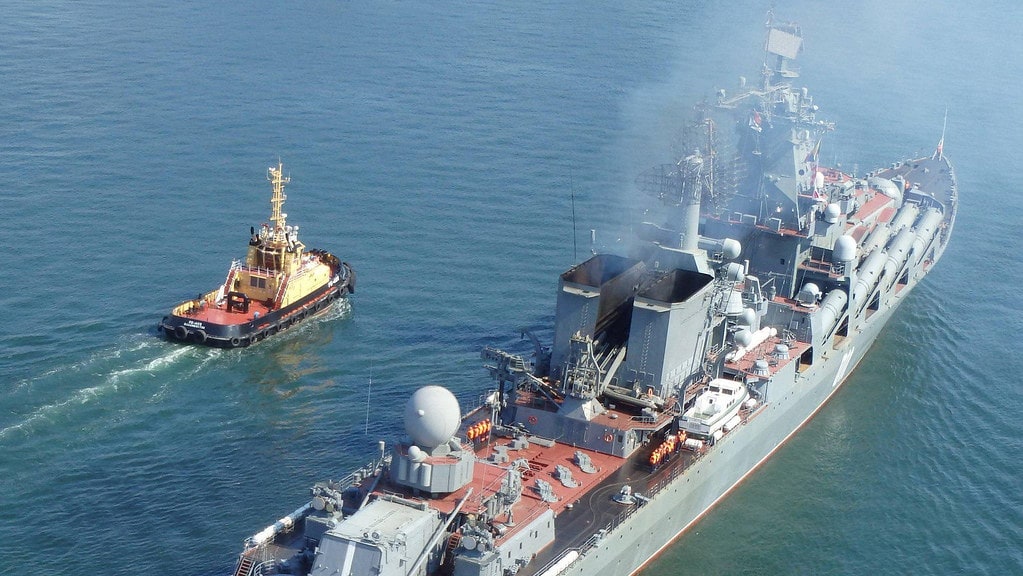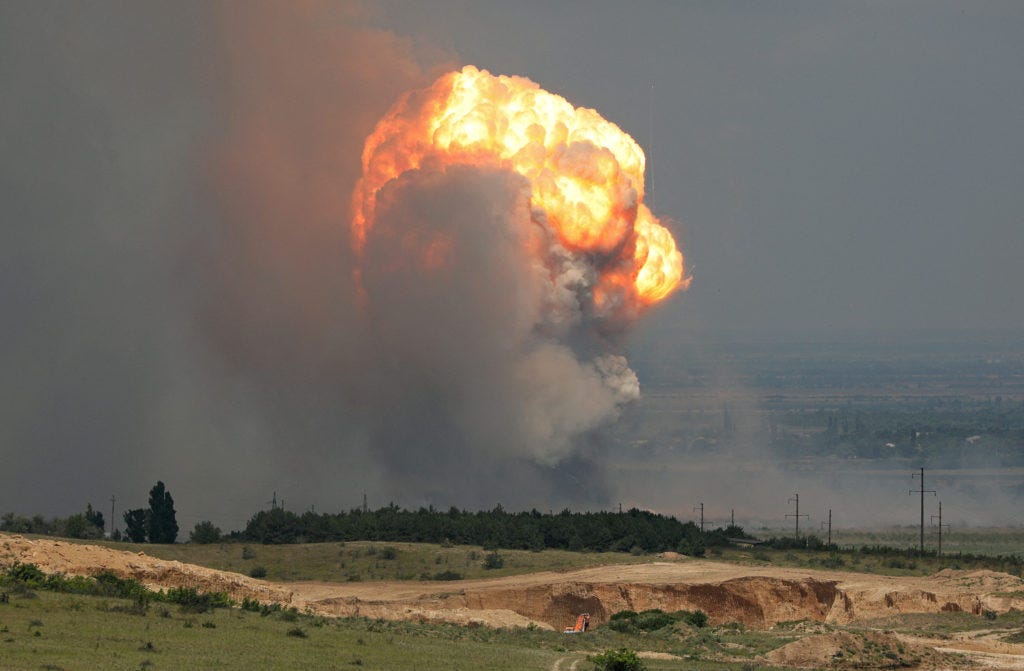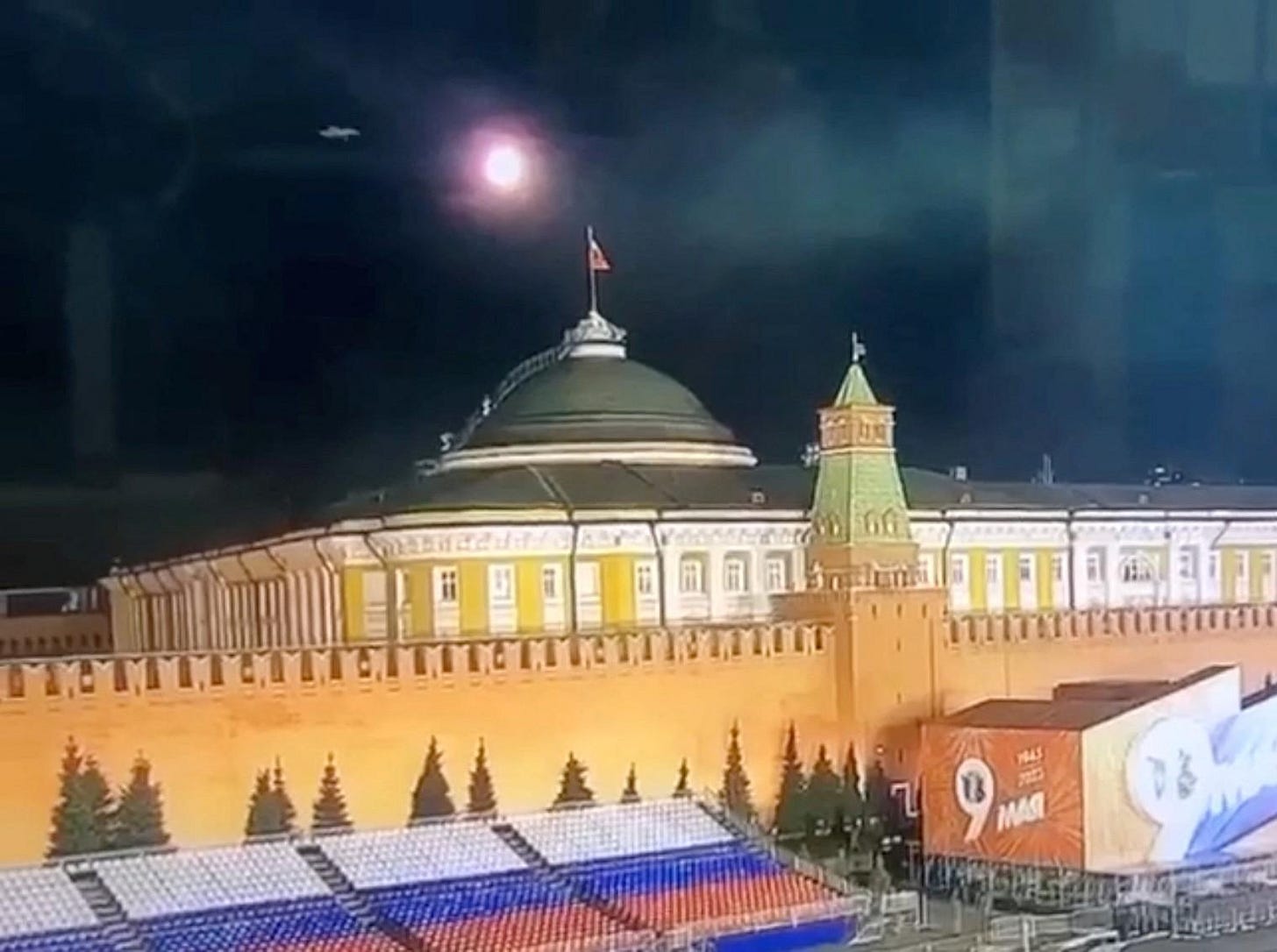Bombing to Lose - Perverse Incentives and Strategic Bombing in Ukraine
We know strategic bombing doesn't work, so why do states find it so hard to resist?
Strategic bombing has never been effective. Despite the massive bomber fleets of the Allied powers in the Second World War and the immense devastation unleashed by them on the Axis homelands, no power surrendered before invasion by land was imminent. It was not the firestorms of Tokyo and Hamburg that ended the war, but the occupation of the German homeland and the atomic bombings of Hiroshima and Nagasaki that proved decisive.
Even as an auxiliary arm, the absolute aerial supremacy of the Allied powers was unable to break the back of German industry. From the outbreak of the war until 1945, German armaments production increased, even as its cities were scorched from the air. Nevertheless, this was not enough to end the myth of the strategic air offensive. The United States attempted the same approach in both Korea and Vietnam, expending vast amounts of costly weaponry on campaigns that ultimately played little role in determining the peace that followed.
The title of this post is a riff on the title of Robert Pape’s book Bombing to Win (link to Amazon, as an Amazon Associate I earn from qualifying purchases) that makes the aforementioned case. Here I seek to explain the continued use of strategic bombing, despite the apparently clear historical record against it.
With the rise of precision guided munitions (PGMs) the US Air Force turned towards another mission to replace area bombing. In addition to tactical close air-support, the USAF embraced the mission of operational interdiction. What this meant was that in a potential Cold War-gone-hot scenario, air superiority would be used to hinder or prevent the movement of Soviet reserves, allowing breakthroughs to be exploited and preventing the Soviets from fighting a mobile war due to the threat from the air.
After the success of air power in the Gulf War, aerial doctrine moved towards the concept of “Shock and Awe,” which can best be understood as interdiction escalated to the strategic level. The aim was not merely to paralyze enemy ground forces, but to paralyze all elements of government and society through attacks on communications, power, and centers of government. This doctrine was designed with wars against weaker powers in mind and was most notably used to mixed results in the 2003 Iraq War.
It seems that Russia, despite the historical record, in its failed imitation of the shock and awe campaign, has been engaged in a campaign of terror bombing of Ukrainian cities. As this winter continues, we have seen an increase in the frequency and scale of these attacks. In the winter of 2022-2023, we saw mass attacks on Ukrainian electrical infrastructure during the coldest times of year. These attacks were designed explicitly to inflict suffering upon Ukraine’s civilian population. These attacks therefore constitute a war crime, but more than that, they are a mistake on the part of the Russians.
To explain clearly why terror bombing is ineffective, despite its apparent psychological and propaganda value, it is necessary to turn to economics. Economics is the science of allocating scarce resources and thus has clear relevance to discussing warfare. After all, there is no fighting force on Earth that has every capability at the precise time and location it is desired. Inevitably, there is scarcity, which creates the need to weigh priorities.
More specifically, I want to borrow a concept in economics known as “opportunity cost.” Most basically, this is the idea that the cost of something is not only what you pay to acquire it, but also what you are giving up the chance to otherwise purchase. That is to say, buying something means giving up the next best thing on offer. In ordinary consumer life, it means that in order for you to go out and buy something, you must consider it not only worth your money, but more worthy of your money than all other alternative uses of that cash.
In the context of bombing, this means that the metric by which the appropriateness of a strike should be judged is not merely by the military advantage gained from it, but from how it compares to the next best option. As a crude example, a cruise missile might be used to take out an infantry fighting position. The killing of enemy personnel is a fundamental part of war and the most basic way to gain an advantage. Yet this is clearly an ineffective use of resources. There are more valuable targets that should be prioritized for the limited stock of cruise missiles available.
This principle is of especial relevance to the war in Ukraine, where both sides must be parsimonious with their limited arsenals. This is why it remains baffling to see Russian cruise missiles used in deep strikes against Ukraine’s urban areas. Even presuming that these are directed at government offices or other targets of some military importance and not the apartment buildings that they tend to hit in reality, the choice of target is hardly any better from a military standpoint. There are far more suitable targets than munitions available to the Russians. Why then, are they choosing to attack unsuitable targets that represent a waste of munitions?
The answer I propose to this seemingly paradoxical behavior is that this is a case of internal politics interfering in the prosecution of a war. The concern is not just the intrusion of the political into the military sphere, as Clausewitz pointed out, there is an essential unity between them and it is therefore completely appropriate for civilian leadership to subordinate military efficacy to political needs. Instead, strategic bombing, especially terror bombing, has a number of perverse incentives that make this kind of misallocation of resources for political reasons more likely. The dangerous allure of strategic bombing is in expending military power for immediate political capital. Few other actions produce political acclaim as reliably as deep strikes on the enemy. The propaganda value of striking at the enemy center of government is far higher than blowing up an ammo dump. Yet the military value of the two has an inverse relationship.
Propaganda value is an appropriate consideration in the prosecution of war. As Clausewitz emphasizes, war is a human endeavor, and its psychological dimension rightly takes central place. Yet the psychological effects of strategic bombing are extraordinarily limited. Terror bombing has no history of success. Striking the capital of an enemy has important symbolic value, but there are almost no benefits for a raid being more than a token force. These efforts present a comforting illusion of power and success, but are in truth nothing more than the squandering of resources.
Certainly, Putin gains support with the ultranationalist bloc in Russia through the terror bombings of Ukrainian cities, Kyiv in particular. However, the relationship is not one merely between Putin and the public, but also between Putin and Russian air command. High profile strikes against the Ukrainian capital are a way to signal to Putin that the air forces are doing good work and ought to be allocated further resources. The success of these strikes, irrespective of the cost-benefit, is therefore a potent tool of internal politics. As the Russian army is struggling to make progress, the air force can offer the deep strikes and their propaganda value as evidence of success in the air.
This brings us to the matter of mission-seeking. There is a tendency for military leadership to press political leadership for something to do and that something can be done becomes an argument that something should be done. This is understandable: there is no military theory that advocates for standing still. Yet, every rule has its exception, and the case of deep strikes is one where it is worthwhile to keep one’s proverbial powder dry. If there is not sufficient intelligence available to conduct strikes on targets of sufficient military value or a target too heavily defended, then acting means squandering valuable resources.
Yet, inter-service rivalry also plays its part in reinforcing this behavior. Branches of the armed forces desperately fear losing funding, prestige, influence, and outright relevance through being sidelined in a conflict. It’s exceedingly difficult and therefore rare for a branch leader to tell the commander-in-chief not to offer them any more resources because there’s not all that much they can do for him, even if that is the unvarnished truth.
Ukraine, by contrast, has conducted its own campaign of deep strikes. These have proven far more effective than most Russian strikes, particularly compared to those targeting urban areas. The reason for this is that these strikes are framed directly in military terms, following more in the tradition of interdiction than terror bombing. By examining these cases of success, a clear contrast in value is drawn with the Russian tendency to target civilian infrastructure.
Four areas in which Ukraine’s deep strikes have been effective are:
Strikes on the Black Sea Fleet
Strikes on ammunition dumps
Strikes on command positions
Strikes on aircraft
What these strikes have in common is a focus on targets of clear and direct military significance. Unlike other campaigns, they do not target the morale or psychological will of the enemy writ large. Instead, they are focused on degrading the enemy’s capabilities and as such have immediate operational effects.
Strikes of the Black Sea Fleet limit its ability to fire cruise missiles in support of Russian ground operations or conduct deep strikes of its own. This effect is achieved both through the actual destruction of platforms but also through the deterrent effect, as the Russians must weigh the risk of losing an irreplaceable vessel against the cost of keeping the fleet idle during the conflict.
Strikes on ammunition dumps have obvious operational effects. A sudden lack of ammo in an area of the front can allow the Ukrainians to gain a temporary fire superiority advantage and inflict asymmetrical losses on the Russians. The sudden loss of such a quantity of weapons may also have larger disruptive effectives as other operational plans are modified to account for the shortage. Similarly, hitting command positions means killing or incapacitating officers, creating confusion in the enemy chain of command and limiting their ability to react to developments on the battlefield. Strikes on aircraft and airfields have immediate operational consequences in that even if the targets can ultimately be repaired, the aircraft are unable to conduct operations at that particular moment, which may have compounding consequences on the battlefield.
What’s more, each of these cases also contain a valuable strategic dimension.
By striking the Black Sea Fleet, Ukraine has increased its ability to export grain after Russians abandoned the original deal and refused to negotiate another. In so doing, Ukraine gains both funds and international political capital. As well, the toll it exacts on the Black Sea Fleet is far in excess of what Russian shipyards or defense spending is able to replace. As such, the continued sinking of the Black Sea Fleet is a strategic cost Ukraine is imposing on Russia for the continuation of the war. Russia can end the war and preserve its fleet or drag it out and lose more and more ships to drones and missiles.
The strikes on ammunition dumps also have their strategic dimension. The nature of warfare in Ukraine has taken on the character of an artillery duel on account of universal weakness in the air. The result is that both sides have suffered acute shell shortages. As such, the destruction of ammunition not only has immediate operational effects, but limits the overall ability of the Russians to take the strategic offensive.
By killing Russian officers Ukraine furthers its strategic objectives by reducing Russia’s technical capacity to continue to prosecute the war. As experienced personnel become unfit for service as the result of these deep strikes, they must necessarily be replaced with personnel who have less experience in the roles in question. As such, the greatest significance of strikes targeting Russian officers is not in the immediate disruption they cause, but in the long term degradation of the leadership of the armed forces.
Targeting airframes on the ground is relevant as a strategic component of the air war. By destroying Russian warplanes, Ukraine not only limits the ability of the Russians to conduct their own strikes, but increases the odds that Ukraine will be able to make gains in the air when it receives western fighters. Russian aircraft losses have all the more significance because of Russia’s inability to mass-produce replacements. Russia’s military aviation sector has proven able to produce semi-modern fighters, but only in an artisan fashion. For instance, when it comes to Russia’s most modern aircraft, the Sukhoi Su-57, there are speculated to be a maximum of 15 in service. By contrast, the United States has 450 F-35 fighters in service. To add insult to injury, the Netherlands currently operates 28 of these fifth generation fighters. Of course, the Russian air force consists of far more than just the most modern fighters, but their scarcity is illustrative of the current state of the Russian military aerospace manufacturing base.
These cases illustrate the potential of deep strikes when directed at appropriate targets. Russia has not entirely failed to find targets of a similar nature, having managed to destroy Ukrainian ammunition dumps and, in a notorious incident, striking a medal ceremony causing mass casualties. Ukraine, for its part, has not entirely refrained from strikes with more propaganda than military virtue to them, with its high profile drone attack on the Kremlin in May of this year, amidst other drone strikes in Moscow.
A distinguishing factor in the strategic bombing campaigns in the Ukraine War is that it has increasingly shifted away from the costly traditional methods of heavy bombers, precision-guided munitions, and cruise missiles and towards low-cost drone attacks. This is the most compelling argument in favor of strategic bombing, that it will be different this time around. No longer do mass flights of bombers or missiles with expensive guidance systems need to be used, now commercial drones costing no more than a couple thousand USD can be jury rigged into precision attack weapons capable of deep strikes.
To this, I would say that however cheap a Shahed attack may be, if its only effect is to cause small-scale harm to the civilian population, then it has no military value. Using any amount of resources is still a loss if nothing of military value is achieved. Returning to the question of opportunity costs, what else might the Russians have used these drones for? It’s certain that there’s no shortage of Russian company and battalion commanders that would have loved to have a greater quantity of suicide drones available to attack Ukrainian positions before assaulting them. As such, every munition used to attack Ukrainian apartments or civilian power infrastructure is one that is not being used to weaken Ukraine’s ability to actually wage war or enable Russia to advance.
At the same time, Ukraine must be wary of the allure of strategic bombing. The danger of these wasteful attacks is that they do in fact have strategic justifications. It is just that these strategic benefits are however out of proportion to their costs, both direct and in terms of opportunity cost. That there is something that can be done with dramatic effect all too frequently obscures the more banal calculus that reveals the more optimal but less interesting places the resources could be allocated.
As aforementioned, Ukraine has conducted attacks of its own on political infrastructure in Moscow. Certainly, if the security service believed it had a chance of killing important Russian political figures, the cost was worthwhile. As well, a token attack on the Kremlin may be a powerful propaganda victory and a sign of strength, shaking preconceptions of Russian invulnerability.
Yet, unjust as it may be, Ukraine must not only fight for its survival, but win the approval of observers. Attacks on Moscow imperil this second objective. While they show that Russia is not invulnerable, they create an opportunity for a segment of the population to draw false equivalence with Russian terror bombing. Some of these people would never have been persuaded to support Ukraine under any circumstances, but many are simply disengaged from world affairs and learning about them only through osmosis. Their understanding of the conflict may then be no more extensive than “both sides are bombing each other” leading to a lack of political support for further military aid to Ukraine.
The other kind of person these attacks risk losing is the one that is concerned about escalation over all else. Some of these types have already proven unwilling to support Ukraine at all, arguing that the West should sacrifice Ukraine on the altar of fear of nuclear war, no matter how infinitesimal the odds or the consequences for the Ukrainian people. But many of those concerned about escalation have taken a more moderate tack and supported various types of weapons being delivered to Ukraine, even if they expressed reservations about tanks or fighter jets. It is these people, both in the public and among elected officials and bureaucrats, who may be frightened off by the prospect of Ukrainian strikes on Moscow.
Therefore, if Ukraine succumbs to the allure of vengeance, of propaganda, or of mission-seeking, it may find that whatever it gains by bombing it more than loses in other areas. This article is not a uniform call for Ukraine to refrain from striking targets deep into Russia, or to refrain from striking non-military targets of strategic importance, such as industry or political centers. The purpose of this article is to make clear the perverse incentives that often drive strategic bombing in the hopes that Ukraine can avoid them and select targets entirely on the basis of how they further Ukraine’s strategic needs.
As an Amazon Associate I earn from qualifying purchases.











Appreciate your perspective on this, but I think there are other dimensions to Russian strikes against Kiev civilians that should be considered:
- Forcing the UAF to devote missile defense to the capital instead of operational forces
- A “warning” of sorts to the west – “this is the way we fight, if you join the conflict directly expect the same treatment”. This is part of the political dimension which you covered.
- I think the strikes on apt buildings and power plants also demonstrates a severe lack of good ISR for the Russians. Perhaps they cannot find good military targets, and so they resort to google maps?